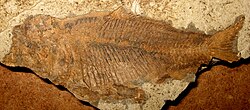Biology:Amyzon (fish)
| Amyzon | |
|---|---|

| |
| 10 cm (3.9 in) A. aggregatum fossil | |
| Scientific classification | |
| Kingdom: | Animalia |
| Phylum: | Chordata |
| Class: | Actinopterygii |
| Order: | Cypriniformes |
| Family: | Catostomidae |
| Subfamily: | Ictiobinae |
| Genus: | †Amyzon Cope, 1872 |
| Type species | |
| †Amyzon mentale Cope, 1872
| |
| Species | |
|
See text | |
Amyzon is an extinct genus belonging to the sucker family Catostomidae first described in 1872 by E. D. Cope.[1] There are six valid species in the genus. Amyzon are found in North American fossil sites dated from the Early Eocene in Montana and Washington (state) USA, as well as the British Columbian sites at McAbee Fossil Beds, Driftwood Canyon, and the "Horsefly shale",[2] as well as Early Oligocene sites in Nevada USA.[1] One Middle Eocene species is known from the Xiawanpu Formation of China. The Ypresian species A. brevipinne of the Allenby Formation was redescribed in 2021 and moved to a separate monotypic genus Wilsonium.[3]
Species
There are six valid species included in Amyzon with up to nine species having been described.[4]
- A. aggregatum Wilson, 1977 Early Eocene (Ypresian), Horsefly Beds, Horsefly, B.C.[2]: 32–40, 41
- A. commune (Cope, 1874) late Eocene Florissant Formation, Colorado (junior synonyms A. fusiforme Cope, 1875 & A. pandatum Cope, 1874 )
- A. gosiutensis Grande, Eastman, & Cavender, 1982 Eocene Green River Formation[5]
- A. hunanensis (Cheng, 1962) Middle Eocene, Xiawanpu Formation, China[6][7]
- A. kishenehnicum Liu, Wilson, & Murray, 2016, Eocene, Kishenehn Formation, Montana[5]
- A. mentale Cope, 1872 Oligocene, Osino Oil Shales, Nevada[1]
- Moved from Amyzon
- A. brevipinne Cope, 1894 moved to Wilsonium brevipinne (Cope, 1894), Early Eocene, Allenby Formation, Tulameen River, British Columbia[3][8]
References
- ↑ 1.0 1.1 1.2 Cope, ED (1872). "On the Tertiary coal and fossils of Osino, Nevada". Proceedings of the American Philosophical Society 12: 478–481. https://archive.org/details/biostor-202570. Retrieved 4 November 2022.
- ↑ 2.0 2.1 Wilson, MVH (1977). "Middle Eocene freshwater fishes from British Columbia". Life Sciences Contributions, Royal Ontario Museum (Royal Ontario Museum) 113: 1–66. https://archive.org/details/middleeocenefres00wils/. Retrieved 4 November 2022.
- ↑ 3.0 3.1 Liu, J. (2021). "Redescription of "Amyzon" brevipinne and remarks on North American Eocene catostomids (Cypriniformes: Catostomidae)". Journal of Systematic Palaeontology 19 (9): 1–13. doi:10.1080/14772019.2021.1968966.
- ↑ Bruner, JC (1991). "Comments on the Genus Amyzon (Family Catostomidae)". Journal of Paleontology 65 (4): 678–686. doi:10.1017/S0022336000030766. Bibcode: 1991JPal...65..678B.
- ↑ 5.0 5.1 Liu, J.; Wilson, M. V.; Murray, A. M. (2016). "A new catostomid fish (Ostariophysi, Cypriniformes) from the Eocene Kishenehn Formation and remarks on the North American species of †Amyzon Cope, 1872". Journal of Paleontology 90 (2): 288–304. doi:10.1017/jpa.2016.28. Bibcode: 2016JPal...90..288L.
- ↑ Liu, J.; Chang, M. M. (2009). "A new Eocene catostomid (Teleostei: Cypriniformes) from northeastern China and early divergence of Catostomidae". Science in China Series D: Earth Sciences 52 (2): 189–202. doi:10.1007/s11430-009-0022-2. Bibcode: 2009ScChD..52..189L.
- ↑ Zhang, J. Y.; Wilson, M. V. H. (2017). "First complete fossil Scleropages (Osteoglossomorpha)". Vertebrata PalAsiatica 55 (1): 1–23. http://www.vertpala.ac.cn/EN/Y2017/V55/I1/1. Retrieved 4 November 2022.
- ↑ Wilson, M. V. (1996). "Fishes from Eocene lakes of the interior". in R. Ludvigsen. Life in stone: a natural history of British Columbia's fossils. Vancouver, BC: The University of British Columbia Press. pp. 212–224. ISBN 0774805781.
Wikidata ☰ Q15361364 entry
pt:Sugador
 |
